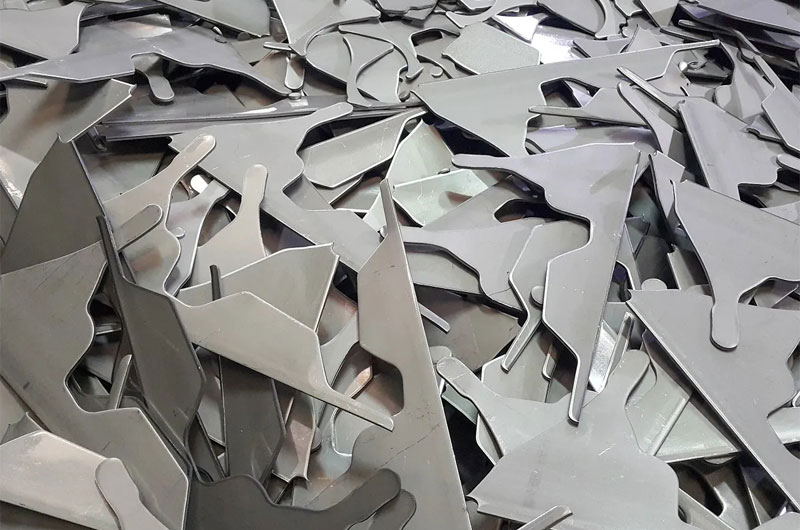In the world of sheet metal cutting, efficiency is key, not only in terms of time and output, but also in material usage. Scrap, or leftover material that cannot be used in final products, is one of the most significant sources of waste in sheet cutting projects.
While some scrap is inevitable, excessive waste translates into increased costs, environmental burden, and inefficiencies in production.
By applying smart design, planning, and cutting strategies, manufacturers can greatly reduce scrap levels and maximize yield from every sheet.
Understanding Scrap in Sheet Cutting
Scrap in sheet cutting projects refers to the portion of raw material that is not used in the final parts. It includes:
- Offcuts: Unused strips or irregular leftovers between or around cut parts.
- Trim Waste: Edges trimmed off to achieve clean borders or tolerances.
- Remnants: Leftover sheets or pieces that are too small for new projects.
- Defective Cuts: Parts with incorrect dimensions, burrs, or distortions due to improper cutting.
The amount of scrap produced depends on factors such as material type, sheet size, nesting efficiency, equipment precision, and the complexity of part geometries.
1. Design Optimization for Sheet Efficiency
The first step in reducing scrap starts at the design stage. Designers should:
a. Standardize Part Sizes
Designing parts with standard dimensions that align with commonly available sheet sizes helps reduce the need for resizing or trimming.
b. Use Modular Part Layouts
Design parts to be modular and compatible with each other in a way that facilitates tighter nesting (placement of parts on the sheet). Rectangular and symmetrical parts typically nest better than irregular shapes.
c. Avoid Sharp Internal Corners
Sharp inside corners can cause stress concentrations and increase cutting complexity, leading to defects and more scrap. Smooth, rounded corners are easier to cut and produce less waste.
d. Incorporate Shared Edges
Where feasible, design adjacent parts to share cutting lines. This reduces cut length and material used between parts, known as “kerf” loss.
2. Intelligent Nesting Strategies
Nesting refers to the process of arranging parts on a sheet to maximize material utilization. Advanced nesting software is essential for reducing scrap.
a. Automatic Nesting Software
Modern CAD/CAM systems offer automatic nesting algorithms that calculate the most efficient arrangement of parts on a sheet. These systems consider material type, grain direction, part quantity, and cutting method.
b. Manual Adjustments
In some cases, experienced operators may override automatic nesting to manually adjust layouts for better yield, especially when dealing with non-standard parts or small batch sizes.
c. Clustered Nesting
Grouping similar parts together or placing multiple small parts within the open areas of larger parts can significantly reduce wasted space.
3. Choose the Right Cutting Technology
Different sheet cutting technologies—laser cutting, plasma cutting, waterjet cutting, and mechanical shearing—have varying degrees of precision and kerf width, which directly impact scrap levels.
a. Laser Cutting
Laser cutters deliver exceptional precision and tight tolerances, which helps reduce material waste. Their narrow kerf width also reduces spacing between parts.
b. Waterjet Cutting
Waterjet cutting produces no heat-affected zone (HAZ) and allows for tight nesting due to its fine jet. It is ideal for delicate materials or intricate shapes where scrap must be minimized.
c. Shearing
While shearing is fast and efficient, it’s typically less precise and best suited for straight cuts. It can produce more scrap unless carefully planned.
4. Maintain Cutting Equipment
Precision is key to reducing defective cuts and wasted material. Poorly maintained machines can misalign, produce burrs, or cut inaccurately.
a. Regular Calibration
Cutting machines should be regularly calibrated to ensure dimensional accuracy. Even minor deviations can result in unusable parts and increased scrap.
b. Replace Worn Components
Worn-out nozzles, lenses, blades, or torch tips can reduce cut quality. Regular inspection and timely replacement are essential.
c. Preventive Maintenance
A preventive maintenance routine minimizes the risk of unexpected machine downtime and maintains consistent cutting performance.
5. Use Scrap Tracking Systems
Implementing a scrap tracking system enables manufacturers to analyze where and why material is wasted.
a. Digital Monitoring
Software systems can track material usage in real time, flag excessive scrap rates, and associate them with specific machines, shifts, or operators.
b. Continuous Improvement
Analyzing scrap data allows continuous process improvement, enabling teams to adjust workflows or retrain operators to prevent recurring issues.
6. Optimize Sheet Sizes and Inventory
Using sheet sizes that closely match the project requirements is critical for minimizing leftover material.
a. Custom Sheet Sizing
When possible, order custom-sized sheets that match your part designs. This avoids excessive trimming and unused borders.
b. Standardize Material Usage
Using a few standard sheet sizes across multiple projects improves purchasing efficiency and allows for better nesting strategies.
c. Use Remnants Wisely
Store remnants in an organized way and track their dimensions for use in future jobs. Many nesting systems allow integration of remnant libraries to use leftover sheets efficiently.
7. Employee Training and SOPs
Human error is another common cause of scrap. Proper training and standardized procedures are essential.
a. Operator Training
Ensure all machine operators understand the cutting process, machine settings, and how to identify potential issues before cutting begins.
b. Quality Checks
Implement standard operating procedures (SOPs) that include pre-cut inspections, material verification, and trial runs where necessary.
c. Communication
Ensure smooth communication between design, programming, and production teams to avoid misunderstandings that can result in scrap.
8. Adopt Lean Manufacturing Principles
Lean manufacturing focuses on eliminating waste in all forms, including material scrap.
a. Just-in-Time (JIT) Cutting
Cutting materials only when needed prevents overproduction and reduces the likelihood of outdated or damaged sheets being discarded.
b. 5S Workplace Organization
Keeping the cutting area clean and organized reduces handling errors and ensures that remnant sheets are easy to locate and reuse.

